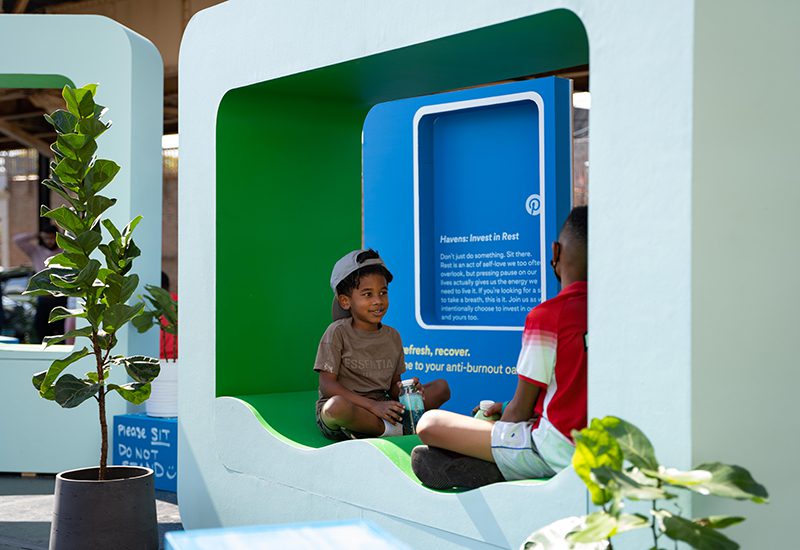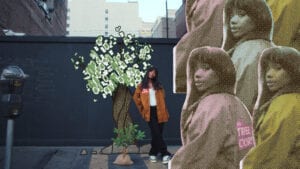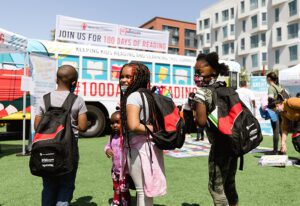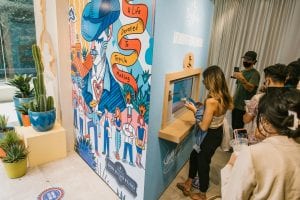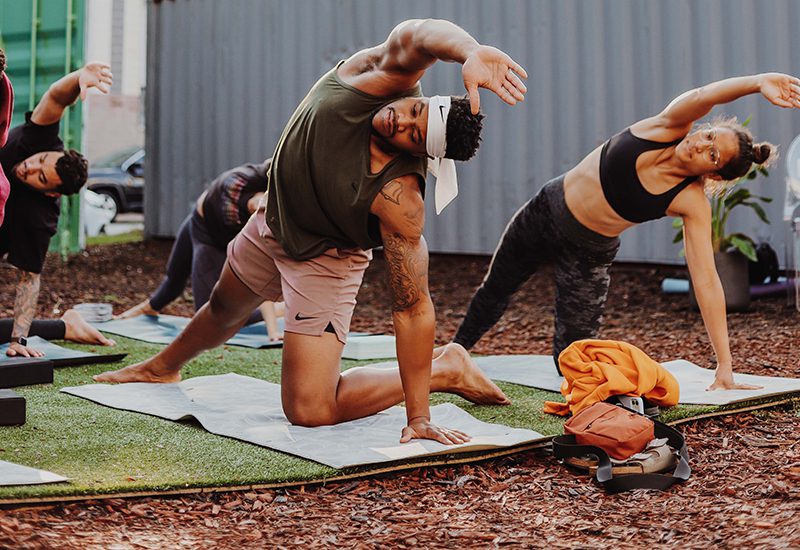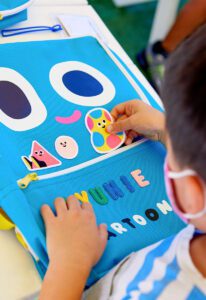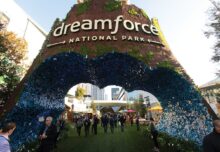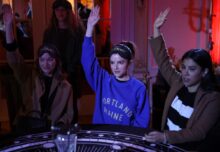Between climate change, widespread racial injustice, deeply divided political lines and, oh yeah, that pesky global pandemic we’ve been battling, it’s more critical than ever for brands to prove that they support causes that are bigger than business. And it can’t just be about optics—the young consumers driving cause marketing’s modern evolution are particularly adept at seeing through flowery language and empty promises.
Enter: the cause marketing activations and events implemented in 2021, which included an array of stunts and adventurous calls to action. At the hybrid Essence Festival, for instance, in-person attendance was free, but attendees had to volunteer with one of 18 charitable organizations on activities that boosted the local community, such as working in a garden, delivering food or assisting the elderly.
 More Cause Marketing Activations:
More Cause Marketing Activations:
- Common Ground: Stand Together Talks Immigration On National Pop-Up Tour
- How Ally ‘Totally Covered’ the Cost of Consumer Experiences Across New York City
In other scenarios, cause marketing activations were specifically created to drive support (and dollars) for a particular cause. Like Hulu, which marked Pride Month by erecting flower sculpture installations that featured voice recordings from prominent LGBTQ+ artists, creators and activists, and QR codes that led to a microsite where consumers could craft a virtual flower, triggering a $15 donation that Hulu split among four LGBTQ+ charities.
And then there were the nonprofits that produced their own cause marketing activations, which brands could draw inspiration from. That includes animal shelter PAWS Chicago, which took a light-hearted approach to the serious matter of animal welfare. Cruising around Chi-Town in a branded van, the organization blasted “Who Let the Dogs Out” (a song once ranked the third-most annoying track ever recorded by Rolling Stone) nonstop until someone donated to the shelter (The Escape Pod, Chicago, handled). Akin to a moving billboard, the van had the phrase “stop this song” painted on its side next to a number to text to make a donation and get some auditory relief.
Clearly, there’s plenty of room for creativity within the cause marketing landscape, so we rounded up eight of this year’s most compelling cause-based experiences that helped brands do well by doing good.
CREATING A CORPS
Tazo Tea
Trees can transform neighborhoods by absorbing air pollutants, adding greenery, enhancing air and water quality and lowering energy costs, among other things. But not all neighborhoods enjoy these benefits equally. Tazo Tea looked to change that with a climate justice cause marketing campaign targeting economically disadvantaged neighborhoods and communities of color. The brand’s new Tazo Tree Corps, a tree-planting workforce, is dedicated to planting and maintaining green spaces across the U.S.
According to Cornell University research cited by the brand, BIPOC communities have 20 percent fewer trees on average than white communities. And these groups have also been disproportionately affected by climate change. So Tazo teamed up with nonprofit American Forests and singer and activist SZA to enhance select cities’ “tree equity,” or the ability for people in every community to receive the benefits that trees provide, regardless of income, race or location.
The initiative aligns with Tazo’s customer base, which is passionate about climate justice. “Our Tazo fans, many of whom are young adults, care deeply about sustainability efforts and are very aware, especially today, of where and how they spend their dollars,” says Laraine Miller, president at Unilever Tea Americas. (Agency: Edelman) –K.H.
GOING LOW-KEY
Thomas’
Thomas’ served up its English muffin brand’s “Wake Up to What’s Possible” messaging and a healthy dose of cause marketing in the great outdoors to engage consumers in volunteer-led cleanup events honoring National Public Lands Day.
The brand leveraged the volunteer networks of its Pacific Northwest nonprofit partners to spread the word about restoration projects among local consumers. Volunteers gathered to improve the ecological health of forests in Lake Sammamish State Park near Seattle and Wallace Park-Leif Erikson Trailhead in Portland, OR, by weeding, collecting trash and completing beautification efforts including creating more accessible trail systems.
Following their volunteer work, consumers were treated to food from two local eateries, which catered a breakfast featuring Thomas’ products. The brand plans to grow the cleanup program into a larger, annual event benefitting local organizations.
“Our goal is to be part of a community, not just as a big brand,” says Michael Jensen, brand manager for Thomas’. “This is a different type of experiential. It’s about connecting with consumers in a totally different way. It’s about feel-good KPIs.” –A.Z.
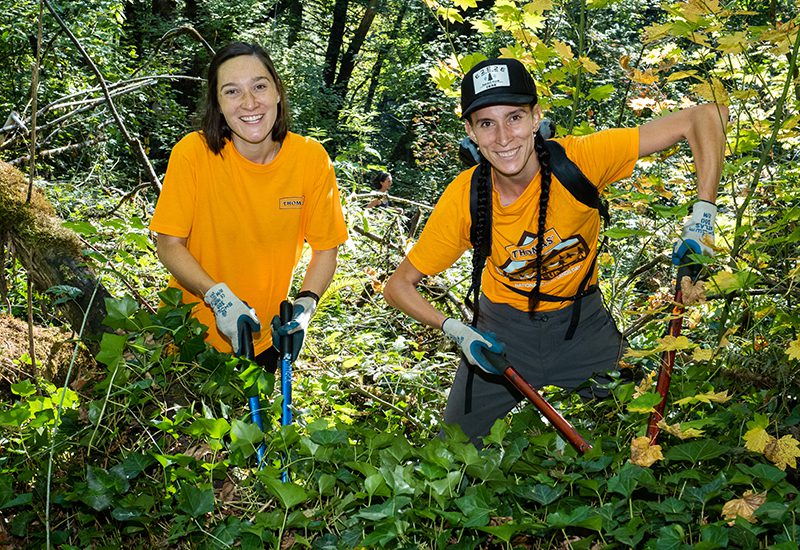
Thomas’ recruited volunteers for clean-up events to help improve the ecological health of forests in the Pacific Northwest.
PARTNERSHIPS
Save the Children
To keep underserved kids engaged in learning and prepare them for the school year while on summer vacation, Save the Children took its digital 100 Days of Reading youth literacy program on the road. With help from brand partners T.J.Maxx, SC Johnson and Nickelodeon, the organization delivered school supplies-filled backpacks and educational games to children and families on a national mobile tour.
To bring the digital concept into the real world, Save the Children and its partners worked with local organizations to identify the most underserved elementary school-aged kids in each city on the tour, and provided them with hands-on learning activities and essential resources.
At each stop, a full event popped out of Save the Children’s tour vehicle. Young attendees were encouraged to participate in a range of educational activities that centered on literacy, math and STEM. An interactive kindergarten readiness activation, for instance, featured a larger-than-life magnetic storybook developed around Nickelodeon’s “Blue’s Clues & You!” program and served as a Mad Libs-like activity that encouraged kids to fill in blanks with their own pictures and words.
“Bringing together like-minded partners who want to make a difference for children is really key to helping make events like this even more impactful and meaningful for kids,” says Jennifer Kendra, head of cause marketing and partnership development at Save the Children US. “SC Johnson, for example, really believes in contributing to the wellbeing of communities by supporting initiatives that enhance that quality of life. And they believe that education is an essential part of helping families move out of poverty and have access to greater economic mobility… So it’s bringing together all these like-minded folks into an opportunity for us to really engage hands-on.” (Agencies: Inspira Marketing Group, production/creative; Trinity Displays, mobile build)
ACCESSIBILITY
Kohl’s
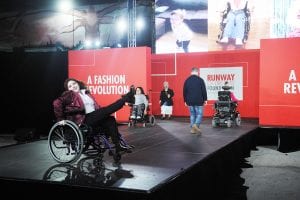
Kohl’s served as presenting sponsor of an inclusive drive-in fashion show promoting adaptive fashion.
There is an unexpected benefit to activating a fundraising event within a pandemic environment: accessibility. In the case of Runway of Dreams, a nonprofit that promotes adaptive fashion for people with disabilities, going beyond the gala helped boost the profile of its Fashion Revolution drive-in event and secure a title sponsor in Kohl’s.
Runway of Dreams typically hosts a gala to coincide with New York Fashion Week. Last year, it offered an all-digital show. So, over the spring, with no restrictions on in-person events in Florida, the organization added a live runway show to its virtual presentation. Forty cars filled the lot at the Carpool Cinema Wynwood in Miami to watch a fashion show, joined later by more than 3,000 consumers who watched on-demand within 20 hours of the premiere. The new concept was more accessible in terms of the number of people who could access the show, the price point compared to a formal gala, and, of course, fashions from the sponsors.
Kohl’s began its sponsorship in 2019 when it introduced adaptive apparel to its three largest kids’ brands and became the show’s presenting sponsor this year. At the event, participants of different physical abilities, age, race and gender were cast as models. Celebrity host Joey Fatone even took a walk down the runway with his daughter, who is on the autism spectrum.
“We are committed to creating an environment where everyone feels a sense of equity, where diversity is valued at all levels and where inclusion is evident across our business,” says Anne Johnson, senior manager-community relations marketing at Kohl’s. “This is a critical part of our marketing strategy as well, especially when you think about the diverse customer base and the families that we serve. We love that Runway of Dreams works with models with different disabilities, ethnicities and backgrounds and that young people can see themselves represented.” (Agency: Revolution Marketing) —B.K.
DIGITAL CURRENCY
Tequila Don Julio
Tequila Don Julio wanted to make this year’s Cinco de Mayo memorable. And thanks to its own digital currency and an ATM—that’s Automated Tequila Machine—the brand prevailed.
Don Julio took a thoroughly modern approach to the campaign: Using of-the-moment digital tools—digital currency, Venmo and Instagram—it encouraged people to return to local bars and restaurants that were hit hard by pandemic lockdowns.
The spirits brand created its own digital currency, designed by the Mexican artist Claudio Límon, dubbed “Don Julio Cincos.” For five days in May, 3,000 Cincos were up for grabs daily. Consumers could win them by swiping up on the brand’s Instagram Stories posts announcing each day’s drop and then entering their information on a microsite. They could redeem Cincos for a $5 credit delivered to them via Venmo and were encouraged to use the money to buy a drink at their favorite bar or restaurant.
Consumers in Los Angeles could withdraw physical Cincos at an Automated Tequila Machine. Visitors to the pop-up space in West Hollywood could collect the colorful currency by scanning a QR code on the screen. The ATM randomly dispensed up to 10 Cincos with unique PINs that they could use to get a Venmo credit—up to $50 per day per person.
“Cinco de Mayo is a key holiday for us, and we were able to encourage celebrations while also supporting the bartenders and restaurant workers who have always made our Cinco celebrations so special over the years,” says Hadley Schafer, brand director at Tequila Don Julio. (Agency: NVE) –B.K.
POP-UP SPACES
Inspired by user data that showed searches for “Sunday reset routine” have increased sevenfold and “destressing tips” have risen 12-fold, Pinterest launched a hybrid experience, “Havens: Invest in Rest” timed to honor World Mental Health Day. The program introduced consumers to Pinterest’s Compassionate Search tool that directs people to stress-busting resources and activities, and helped position Pinterest as a platform that goes beyond simply searching and “pinning” inspirational images.
The in-person program was designed to be an “anti-burnout oasis,” or healing space for community-driven wellness inspiration, including relaxing imagery and rest idea pins developed by global creators. Attendees could enjoy yoga classes, a portrait studio and healing circle, wellness tonics, vegan food, inspired creator content and a “Chance and Bri’s Books and Breakfast” read-along event in partnership with Chance the Rapper.
“From a strategic perspective, it was really about highlighting our commitment to emotional wellbeing. If you want to create inspirational spaces, you have to do so intentionally,” says Elizabeth Luke, senior brand communications lead at Pinterest. “Instead of trying to keep people on a [Pinterest] board, we also wanted to engage them in real life and cultivate emotional wellbeing that happens off the platform.” (Agency: In-house). –A.Z.
INCLUSIVITY
WarnerMedia Kids & Family
Akin to Save the Children’s cause marketing approach, WarnerMedia Kids & Family, which offers an expansive content catalogue on HBO Max and Cartoon Network, launched a mobile tour aimed at uplifting kids in need, and promoting its “Cartoonito” preschool programming block, which airs on both networks and champions inclusivity.
The tour supported WarnerMedia’s mission to give away 10,000 Cartoonito-themed backpacks to preschoolers nationwide, including donating 5,000 of them through the Kids In Need Foundation, which provides access to quality education. Filled with school supplies and fun creativity kits, the bags were distributed to young children at eight free pop-up events during the mobile tour. At each event, preschoolers could customize their backpacks at a Patch Bar, visit a coloring station where they were encouraged to draw outside the lines and participate in a playful photo op with giant inflatable Cartoonito characters. The brand said the tour and nonprofit partnership were a great way to offer spaces and opportunities where “kids and creativity can find each other.” (Agency: The XD Agency)
ENVIRONMENTAL IMPACT
Coors Banquet x Brixton

Coors Banquet’s intimate benefit event featured a silent auction and an acoustic set by the Cold War Kids.
Founded in Golden, CO, and with deep roots in the Western U.S., Coors’ Banquet brand has been backing the heroic efforts of wildland firefighters by raising funds for the Wildland Firefighter Foundation (WFF) for the last eight years. But amid one of the worst wildfire seasons in history, Coors identified an urgent need this year to move beyond simple donations. So to boost awareness of the foundation, rally consumers around the cause and recognize local firefighters’ efforts, Coors partnered with like-minded West Coast lifestyle brand Brixton to host an intimate benefit concert that was livestreamed on Facebook to amplify national reach and drive donations. The event helped Coors Banquet further its goal of donating $250,000 to WFF as part of its Protect Our West initiative.
In-person attendance at the exclusive benefit concert was limited to local firefighters, along with representatives from Coors, Brixton and WFF. The event featured prominent indie rock band Cold War Kids, who delivered an intimate acoustic performance—a format they weren’t offering to fans along their tour. In addition to the show, attendees could participate in a silent auction benefitting WFF. And thanks to Brixton’s close partnership with Fender, a few guitars from the legendary instrument maker, signed by the Cold War Kids, were up for grabs.
“What we’re definitely noticing is that consumers are looking for brands that have this deeper purpose behind them. And it’s nothing new for us to be supporting the WFF, but we’ve seen a lot of success,” says Stephanie Clanfield, marketing manager at Coors Banquet. “We know that it resonates really well with a younger demographic, so it’s important for us to continue to stay relevant… It’s so, so crucial that brands support making a positive environmental impact at this time.” (Agency: GDX Studios)
This story appeared in the December 2021 issue

